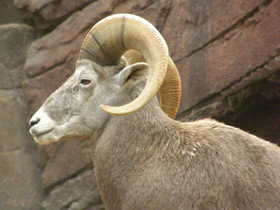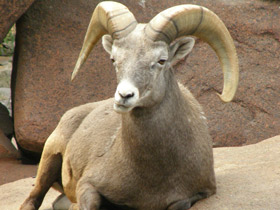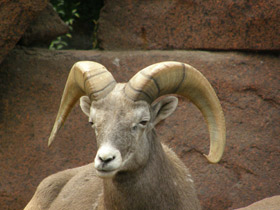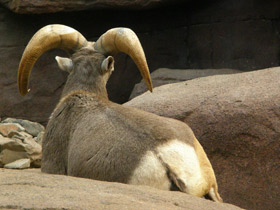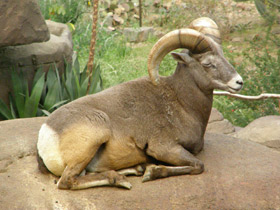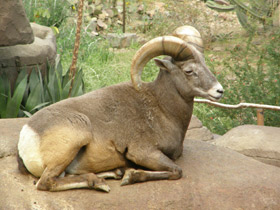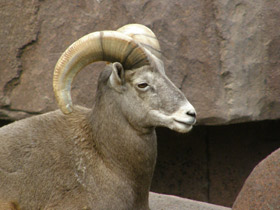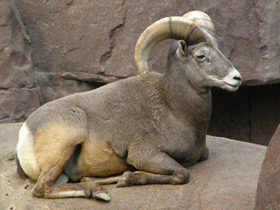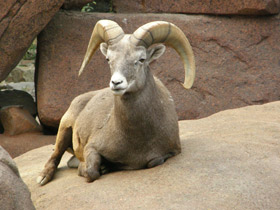The bighorn sheep Ovis canadensis
The bighorn sheep ranges widely in western Canada, western United States, and northern Mexico. These impressive ungulates inhabit alpine meadows, grassy mountain slopes and foothills. In winter, they usually stay at elevations of 1,800 to 2,500 meters above sea level, while their summer range lies between 800 and 1,500 meters. The bighorn sheep has quite stocky powerful body, short strong legs, thick short neck, small head, and a small tail scarcely projecting from the fur. The sizes of these animals vary between bighorn populations but males are always significantly larger than females. Bighorn sheep from the Rocky Mountains are relatively large, with males weighing between 73 and 143 kg (females weigh 53 to 91 kg), while bighorns from the deserts of the southern part of this species range are much smaller: males weigh only 58 to 86 kg and females, 34 to 52 kg. The horns in the males are very heavy and massive and may weigh as much as 14 kg, which is the weight of all the bones in a male’s body. The horns of the females are much smaller and only slightly curved; they are crescent-shaped and curve sideways. Bighorn sheep are well adapted to climbing on steep rocky slopes, though they are not as perfect climbers as the blue sheep, and neither are they adapted to fast long run. The diet of bighorn sheep comprises grasses (cereals, sedges, legumes), berry shrubs (red whortleberry, blueberry), and the leaves, shoots and twigs of available shrubs and trees, such as the willow and birch. In winter, they eat dry grass, forbs, ground lichens, and tree and shrub branches. In summer, bighorns are generally active during cooler time of the day, resting in the shelters in the hotter periods, while in winter they forage through the daytime. These animals have remarkable eyesight but their senses of hearing and smell are not well developed.
The bighorn sheep breeds during November and December. Before the rut, males take part in spectacular display for the dominance. During the fights, the males jump towards each other and clash horns with tremendous force; sometimes fights result in severe damage of the horns. Some people say that the sound of the blows can be heard from a distance of several hundred meters. In the spring, after a gestation period of around 6 months, the female usually gives birth to a single young, though litters of two offspring have also been recorded. The newborn weighs 3 to 5 kg and is well developed. It has fuzzy, dark-grey hair with black stripe along the backbone and white spot on the forehead. The mother nurses the young for 4 to 6 months, with the lambs’ weight increasing by three times in a month, and to 22-25 kg by the autumn. The lambs start browsing grass from the age of 7-10 days and soon the mother and her offspring join the female’s herd. The young can forage independently at the age of 4-6 months. Young females are able to breed at the age of 10 or 11 months but they usually start breeding in the second or third year of life. Young males typically do not breed until they are over 7 years old, when they are able to successfully compete for the access to females. Mature males usually stay apart from females and young for most of the year in separate bachelor groups comprising 4 to 6 individuals. Female groups typically consist of 6 to 8 animals. The lambs live with their mothers. At a later stage, young females generally remain in their mother's group, and males depart when they are two to four years old and join a bachelor group.
Two hundred years ago, bighorn sheep population numbered about 1.5 to 2 million animals but by the beginning of XX century it decreased to less than 10 thousand individuals. This dramatic decline was caused by over-harvesting and competition from domestic sheep. Another major factor is presented by the vulnerability of wild sheep to domestic cattle diseases, such as mange and pneumonia.

















